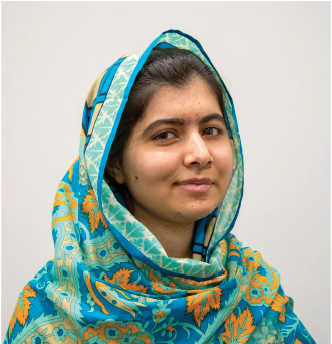Belen Cocke
Guest Writer
On October 9, 2012, on the bus ride home from her end-of-year exams, 15-year-old Malala Yousafzai was shot by a young, zealous Talib. She recounts how a bullet traveled through her left eye socket and into her left shoulder, leaving her severely injured. In her brilliant memoir, I Am Malala (Little, Brown and Company, 2013), the Nobel Peace Prize winner chronicles her fight for equal education for all children in Pakistan under “Talibanization”, a radical terrorist ideology that overtook and corrupted the Pakistani government from the late 1990s and still holds power today.
Rivaling novels that boast fantasy worlds and superhuman situations are typically more intriguing and fascinating than the day to day lives that fail to measure to the same caliber. However, I Am Malala is the exception. It is easily readable and hard to put down; her captivating tale of the struggles of a childhood under a suffocating regime is heartbreaking, and it forces readers, as students, to truly appreciate the education we are handed.
With school starting up again this fall, millions of students across the United States are buckling down for another year of studying, testing and examination. However, not everyone has the pleasure of being able to stress about algebra or history. For some, daring to go to school could cost them their lives. Yousafzai, since the tender age of 11, boasted progressive ideas that included speaking out against the anti-education torrents spread by the radical terrorist group, the Taliban. The Taliban is one of the many organizations of self-proclaimed “enlightened” Muslims, believing that women should not be educated and ordain a life of doing nothing more than marrying and bearing children. Yousafzai likens them to what “the West calls fundamentalists” (Yousafzai 93).
Due to Yousafzai’s courage and strength, she became a beacon of hope for young children all over Pakistan, conversing and debating with adults on national television, calling out the Taliban by name and demanding they allow girls to return to school. Even though this put her on the Taliban’s list, she felt it necessary and that if “[she was] speaking for [her] rights, for the rights of girls, [she was] not doing anything wrong” (141). In the novel, it is addressed that many had believed the Taliban was long gone and that peace might finally return to Pakistan. However, the peace treaty signed in February 2009 between the Taliban and the Pakistani government had been “merely a mirage” (169). The Taliban was (and is) alive and well.
Much to the Taliban’s disappointment, Yousafzai survived and continues to contend for every child’s right to receive a quality education. Through her namesake organization, the Malala Fund, she fights for change through education and empowerment of local communities.
To elaborate, her memoir is beautifully written. She tells the intimate story of growing up, although her circumstances were drastically different than ours. Furthermore, she uses religion as a powerful contradictory and literary tool. The people who tried to silence her preach anti-Islamic statements, all the while operating under a guise of piety. They do not follow the Quran or Allah’s word; they use religion, a part of life even the least educated person subscribes to, as a manipulation tool. Yousafzai comments on this in her novel; the theme of religion and how differently it can be interpreted and twisted shines through: “Some people call themselves Muslim, but their actions are not Islamic” (283). Her style of telling this gripping story through heartfelt and seemingly innocent anecdotes makes her story all the more telling: the signs of corruption are evident, and ones even teenagers may be able to pick up on.
The lighthearted tone Yousafzai uses throughout her memoir is almost eerie in hindsight. We know the tragic outcome, yet reflect on how aloof everyone in the autobiography seemed to have been. That quality is what makes I Am Malala such a great read. This memoir is not only a look into a girl’s life, but a list of what not to do if similar situations arise in our own lives. Everyone, teenager or not, can serve to learn a thing or two from Yousafzai, and other people in her shoes.

